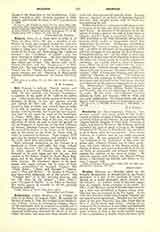

Brindisi, Diocese of.—Brindisi, called by the Romans Brundusium or Brundusium, by the Greeks Brentesion, is a city in the province of Lecce, in Apulia, on a rocky peninsula which extends into the Adriatic. In ancient times it was very important as a seaport, being accessible in all winds. In 245 B.C. the Romans captured Brindisi without striking a blow and established a Roman colony there. This city was one terminal of the Via Appia. In the civil wars between Caesar and Pompey Brindisi was the base of naval operations. Brindisi was the birthplace of the poet Pacuvius; here also Virgil died in 19 B.C., on his return from Greece. During the invasions of the barbarians it was taken and destroyed several times, but was always rebuilt within a short space of time, so that as late as the twelfth century it had a population of 60,000, which has since dwindled to about 20,000. The harbor gradually filled up, which hindered navigation. The Italian Government made great attempts to remedy this, but on account of an error of judgment the beneficial results anticipated were not permanent.
According to a local legend, the first Bishop of Brindisi was St. Leucius, about 165, who later underwent martyrdom. However, taking into consideration the geographical position of this city, the beginnings of Christianity in Brindisi must date back to the first century. There is no historical proof for this except the account given by Arnobius of the fall of Simon Magus, who according to him withdrew to Brindisi and cast himself from a high rock into the sea. The Diocese of Brindisi at first embraced the territory comprised within the present Diocese of Oria. In the tenth century, after Brindisi had been destroyed by the Saracens, the bishops took up their abode at Oria, on account of its greater security. In 1591, after the death of Bishop Bernardino di Figueroa, Oria was made the seat of a new diocese. In the reorganization of the dioceses of the Kingdom of Naples in 1818 Brindisi was combined with the Diocese of Ostuni, formerly its suffragan. Brindisi has been an archiepiscopal see since the tenth century. The ancient cathedral was located outside the city, but in 1140 Roger II, King of Sicily and Naples, built the present cathedral in the center of the city.
The bishops of Brindisi worthy of mention are: St. Aproculus (Proculus), who died in 352 at Ardea, when returning from Rome, and was buried at Anzio; St. Cyprian, who died in 364; Andrea, murdered by the Saracens in 979; Eustachio (1060), the first to bear the title of archbishop; Guglielmo (1173), author of a life of St. Leucius; Girolamo Aleandro (1524), a learned humanist, and papal nuncio in Germany in connection with Luther’s Reformation, and later Cardinal; Pietro Caraff a, Bishop of Chieti, and afterwards Pope Paul IV, for some time the Apostolic administrator of this diocese; Francesco Aleandro (1542); G. Bovio, from Bologna, who translated the works of St. Gregory of Nyssa, and was prominent in the Council of Trent; Paolo de Vilanaperlas (1716), founder of the seminary; Andrea Maddalena (1724), who restored the cathedral after it had been damaged by the earthquake of 1743.
In this diocese is the shrine of Mater Domini, near Mesagne. A beautiful church was erected there in 1605 to replace the ancient rustic chapel. The diocese has a population of 119,907, with 23 parishes, 89 churches and chapels, 181 secular and 15 regular clergy, and 64 seminarians.
U. BENIGNI

